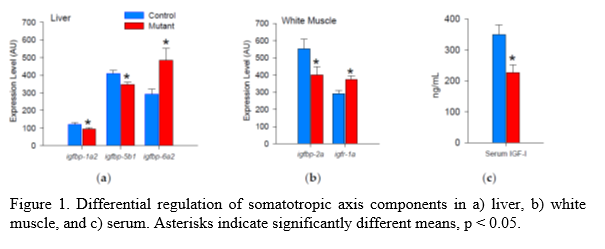COMPENSATORY RESPONSE OF THE SOMATOTROPIC AXIS FROM IGFBP-2B GENE EDITING IN RAINBOW TROUT Oncorhynchus mykiss
Insulin-like growth factor (IGF) is recognized as a central regulator of anabolic growth in vertebrates, largely due to its positive effects on muscle and bone growth. However, t he majority of IGF-I is not free in circulation; approximately 99% of IGF-I is bound to IGF binding proteins (IGFBP). In addition to extending the half-life of IGF-I in serum, IGFBPs sequester IGF-I to peripheral tissues and can promote or inhibit ligand binding to surface receptors . Characterizing the functions of the IGFBP s is essential to understand the role of these proteins as regulators of IGF signaling. We used gene editing technology to edit IGFBP-2b, the most abundant IGFBP in serum that binds an estimated 80% of free IGF-I. The objective of this study is to determine how components of the IGF/IGFBP system respond to a reduction in serum IGFBP-2b abundance.
Rainbow trout with gene editing-induced reductions in serum IGFBP-2b (Mutant) exhibit similar growth performance compared to fish without IGFBP-2b gene disruption (Control). Editing the IGFBP-2b genes resulted in an 83% decrease in serum IGFBP-2b in mutants. This resulted in a 35% reduction in serum IGF-I (Figure 1c) , which was offset by reduced expression of hepatic igfbp-1a2 and increased muscle igfr-1a (Figure 1a,b) ; these responses suggest that an increased IGF-I signaling capacity offset reductions in serum IGF-I. During feed deprivation, the differential expression of igfbp genes supports the attenuation of the growth inhibitory response, likely due to the further reduction in serum IGF-I that alleviated the need for an IGF-inhibitory response. Unique igfbp expression patterns occurred during refeeding, suggesting an enhanced IGF-I signaling capacity in controls. Collectively, these findings support that the role of IGFBP-2b is to regulate serum IGF-I concentrations. The compensatory regulation of IGF/IGFBP system genes indicates that adjustments in other IGFBP, both circulating and at the local level, maintain IGF-I signaling at a level appropriate for the nutritional state of the fish.
